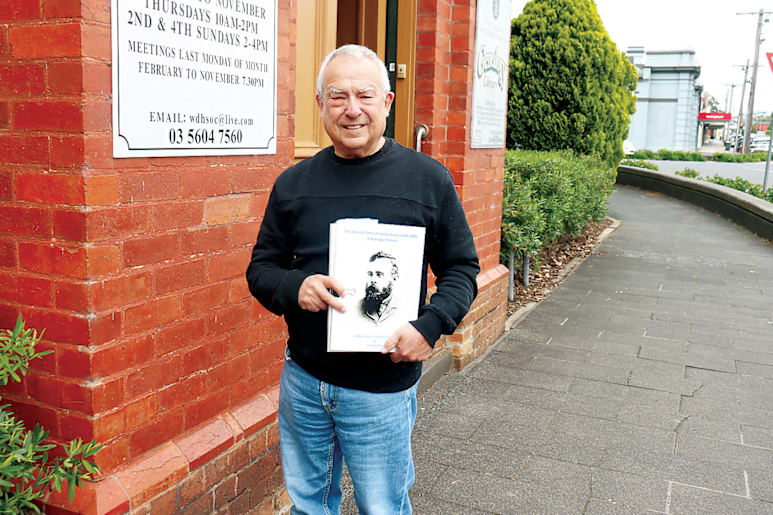
Author of the Life and Times of James Biram, Vaughan Fox with his book.

Author of the Life and Times of James Biram, Vaughan Fox with his book.
by Nick Rowe
Warragul resident and keen historian Vaughan Fox admits to developing a strong emotional connection to James Biram while writing a biography of the pioneer's life.
The Life and Times of James Biram - A Warragul Pioneer was researched, compiled and written by Vaughan with help from a number of people, including some of James' descendants, Kerry Biram and Andrew Biram, who grew up in Warragul.
The book has been an 18-month labour for Vaughan. A volunteer firefighter, his interest in James was piqued when completing a book on the history of the Warragul Fire Brigade.
Vaughan spent hours reviewing newspapers and archives at the Warragul Historical Society and the Warragul and State libraries.
He developed such an emotional connection to James and his family that he admits to becoming quite emotional while writing about James' death. "James was a true pioneer. He was only young when he first came here, but he was obviously a real mover and shaker of early Warragul."
Vaughan said he became deeply intrigued by reading about James' adventures. "Imagine coming all the way across the world from a big city to end up in a pioneer settlement. It was a fascinating life. Hopefully, people who read it will get a sense of what life in Warragul was really like."
"Modern people tend to think of our ancestors as living in a black and white world because that is what old lithographs, photos or newsreels depict. However, their world was just as colourful as ours, but probably more smelly."
James Biram's remarkable journey began in the industrial slums of 1840s Manchester, England, where he was born in 1846.
At age 10, James and his family emigrated to Australia - an arduous sea voyage with cramped conditions and limited hygiene. The family spent time in Adelaide before relocating to Melbourne in 1860.
James was trained in the pharmacy business, learning the trade that would become his profession. His father, Richard, was an engine smith in Manchester but ran a temperance hotel in Melbourne. He was an inventor who patented a mechanism to improve sewing machine operations by steam or water. James's brother, Benjamin, was a tin-smith and later joined him in Warragul running the plumbing side of the business.
In March 1876, James Biram became synonymous with the founding of Warragul. At just 30, he ventured to Gippsland and constructed the first building in the town - a log cabin that served as his home and a general store. He established himself as a chemist and druggist, providing essential medicines, groceries and general goods to isolated pioneers.
The timing was fortuitous. In 1877, surveyor John Lardner laid out the town plan, and James' establishment stood in the middle of what would become Queen St. The arrival of the railway transformed Warragul from a forest outpost into a proper town, and James' store became its commercial heart. The railway was opened at Warragul on March 1, 1878.
Early challenges were numerous. In January 1876, James lost his horse - a significant setback when horses were essential for transport. He dealt with flooding and devastating fires, including one that destroyed his house in Victoria St in 1887.
James was integral in the development of Warragul's early infrastructure. One of his most important civic contributions was establishing the Warragul Fire Brigade. After witnessing multiple devastating fires, James became convinced the town needed organised fire-fighting capabilities.
In July 1883, he wrote to the Shire Council requesting formation of a brigade. In August 1883, he organised a public meeting at Scott's Royal Hotel to establish the service. Vaughan said "Jo from the Warragul Historical Society found that original letter written by James - I just couldn't believe that I was holding something in my hands that was written by the person I was writing about."
James' civic involvement did not end there. In November 1879, he was appointed the first trustee of the Warragul Cemetery. He served on the board of St Paul's Anglican Church from 1887 and was instrumental in establishing the Warragul District Hospital, serving on its committee and helping secure the government grant and land donations. The hospital opened in 1908, after his death.
He also was a trustee of the Warragul Recreational Ground and the Warragul Athenaeum.
James's business acumen proved sharp. By the late 1880s, his "emporium" offered a wide range of goods from pharmaceuticals to groceries, hardware to tinware.
The Biram family business expanded beyond James' store. His brother Benjamin established operations in Melbourne and Maidstone. Their sister Mary held property leases in Warragul.
James' home became a social centre. In December 1879, the Birams hosted an impromptu concert reported in the newspapers, demonstrating the family's hospitality and central role in community life.
The book reveals that James never married, devoting himself to business and community service, although his family remained central to his life.
On March 20, 1905, at age 58, James died of pneumonia at Warragul. The newspapers identified him as the "founder of Warragul." He was buried in the Warragul Cemetery - a place he had helped establish as its first trustee.
Vaughan has written three books detailing his family tree, but his latest effort has strengthened his interest in Warragul's history.
"I think of James and his family often, as well as other Warragul pioneers, when I walk along Queen St to visit the Historical Society or go past the many shops that, while they contain new businesses now, were in existence back in those days."
The biography draws on extensive primary sources: government records, newspaper accounts, court documents, council minutes, church records, land transfers, census data and business advertisements.
Vaughan paid tribute to many who helped him. He acknowledged Trove Newspapers and access to old copies of the Gazette held at the historical society. "I would like to pay special thanks to Malcolm and Jo Dickson and Wayne Hardie from the historical society for helping me in my research and providing advice."
He also thanked Kerry Biram for her help indexing the book and paid tribute to Dave Mifsud at the CCG Copy Centre in Warragul for helping to publish and print the book.
"And I must give special thanks to my partner Janet MacDonald. She has been incredibly patient with me as I have delved so deeply into this project over the last year and a half."





